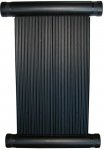I plan to build a 4 x 8 or 4 x 16 solar collector (as seen on YouTube) and I see the volume of water that can flow through the 1/2 inch tube isn't much. My idea is, if I don't want to put too much strain on the pump, it seems like it will be better to "double up" or "triple up" the lines in the heater, to reduce back pressure. I mean, split the inflow into two different heating circuits, or three circuits, so the pump can push against much less restriction (vs. pushing the water through a very long 1/2 inch circuit, it would be pushing it through 2 circuits 1/2 as long, for example.)
I saw one YouTuber who was trying to restrict flow in the heater to increase the temp, and I know that's wrong. If anything, the faster you can get the heat out of the collector, the better (sun heats a cool collector better than a hot one,) as long as you're not using extra electricity to increase the speed.
Will I run into any unforeseen issues with this approach? How do I evenly split the flow between "circuits"?
Thanks,
Scott in Snowflake, AZ
I saw one YouTuber who was trying to restrict flow in the heater to increase the temp, and I know that's wrong. If anything, the faster you can get the heat out of the collector, the better (sun heats a cool collector better than a hot one,) as long as you're not using extra electricity to increase the speed.
Will I run into any unforeseen issues with this approach? How do I evenly split the flow between "circuits"?
Thanks,
Scott in Snowflake, AZ



